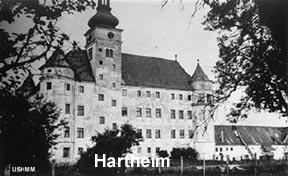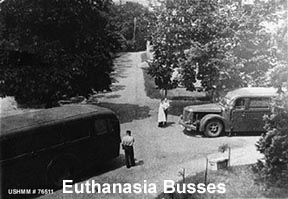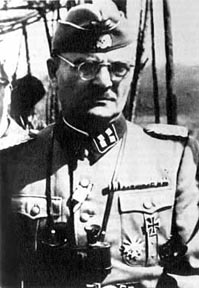 |
 |
Reconstruction of Belzec
1.0 - Historical Background
Belzec was the first of three pure extermination camps organized and constructed between November 1941 and October 1943: Belzec was the first camp to become operational. Sobibor, and Treblinka followed. This effort was referred to by the code words Aktion Reinhard. Under Aktion Reinhard, the Germans murdered most of the Jewish population of Poland, as well as several thousand other Jews from Greece, the Soviet Union and western Europe. All told and estimated 1.75 million people were killed in the three camps - 650,000 at Belzec, 250,000 at Sobibor, and 850,000 at Treblinka.
The road to Belzec was well prepared by the experience the Nazi bureaucracy gained in a euthanasia program directed at German citizens. This program was explicitly ordered by Hitler. It initiated policy of murdering excluded groups of handicapped and disabled individuals throughout Germany. Killing centers were set up at institutions. The first at Grafeneck, and others subsequently at Hartheim. Sonnenstein. Bernburg and Hadamar.
 The methodology and organizational infrastructure was
created to kill thousands of mental patients, disabled adults, and retarded and deformed children. It is noteworthy that not a single stratagem used
in the later genocidal murder process was invented at Belzec or at any of the other extermination camps: Before Reinhard, euthanasia was
performed by using a variety of means. The primary methods was poisoning with carbon monoxide gas in specially build gas chambers disguised to
The methodology and organizational infrastructure was
created to kill thousands of mental patients, disabled adults, and retarded and deformed children. It is noteworthy that not a single stratagem used
in the later genocidal murder process was invented at Belzec or at any of the other extermination camps: Before Reinhard, euthanasia was
performed by using a variety of means. The primary methods was poisoning with carbon monoxide gas in specially build gas chambers disguised to
 look like shower rooms. The victims were selected from resident populations where they has been sent for treatment or long term care. After selection,
they were transported by special busses driven by men recruited into the SS, and taken to one of several regional killing centers. There the victims were
told to undress on the pretext that they were to shower. The shower room turned out to be diguised gas chambers. After their deaths, they were incinerated in crematoria especially built near the
killing chambers.
look like shower rooms. The victims were selected from resident populations where they has been sent for treatment or long term care. After selection,
they were transported by special busses driven by men recruited into the SS, and taken to one of several regional killing centers. There the victims were
told to undress on the pretext that they were to shower. The shower room turned out to be diguised gas chambers. After their deaths, they were incinerated in crematoria especially built near the
killing chambers.
Freidlander has written:
The euthanasia killings-that is, the "systematic and secret execution of the handicapped˘- were Nazi Germany's first organized mass murder in which the killers developed their killing technique. They created the method for selecting the victims. They invented techniques to gas people and burn their bodies. They employed subterfuge to hide the killings, and they did not hesitate to pillage the corpses.
The euthanasia killings proved to be the opening act of Nazi genocide. The mass murder of the handicapped preceded that of Jews and Gypsies; the final solution followed euthanasia. In euthanasia, the perpetrators recognized their limitations and. to avoid popular disapproval, transferred the killings from the Reich to the East. No substantive difference existed, however, between the killing operations directed against the handicapped, Jews. and Gypsies. The killing technique that had been developed and tested in euthanasia was used again and again. The killers who learned their trade in the euthanasia killing centers of Brandenburg. Grafeneck. Hartheim. Sonnenstein. Bernburg and Hadamar also staffed the killing centers at Belzec, Sobibor. and Treblinka. The instigators had learned that individuals selected at random would carry out terrible crimes "without scruples."(Reference 10, p21-22)
Staffing
The administration of the euthanasia program was run by the Nazi Party organization: the Kanzlei des Fuhrers (i.e. - Chancellery of the Fuhrer - commonly termed the KdF) under Viktor Brack. In the beginning, Brack had been faced with the imperative to disguise the who was managing the killing operations. Accordingly, Brack recruited additional needed staff and moved them into a mansion taken from its former Jewish owner at 4 Tiergtarten Strasse. From the address, the euthanasia and the subsequent genocide programs came to be known under the rubric as ˘Operation T-4÷. The individuals recruited to do the killing were known collectively as T-4 personnel
T-4 personnel staffed Belzec and the other Reinhard camps. These people were ordinary Germans, primarily of the working class. They came from a variety of occupations: metal working, nursing, carpentry, masonry, etc.
They were largely a self selected group, volunteers attracted by good pay, other emoluments, and added fringe benefits. As quoted above from Freidlander, the management of T-4 had learned that ordinary individuals would accommodate to committing heinous crimes without great difficulty. There were few sadists among the staff of the institutions and camps. Almost invariably, however, all the staffs became morally corrupted by a willingness to perform the duties of euthanasia without scruples.
Figure 1.0.1 is a well known picture of part of the Belzec German contingent standing muster in the SS compound the winter of 1942-43. The numbered individuals, their prewar occupations, and their institutional assignments Are presented in Table 1.0.1:
Of those photographed, only Lorentz Hackenholt stands out. He was a large man and adept at things mechanical. He ran the gas chambers at Belzec which bore the sardonic plaque: ˘The Hackenholt Foundation÷ at the entrance. He helped build and design the new chambers at the Reinhard camps. He was a favorite of Christian Wirth, the Reinhard camps Inspector. He was a disciplinary problem within the SS.
Command Structure
At the euthanasia centers, the nominal directors were medical doctors and the chiefs of administration and security were police officers. In actuality, as in most Nazi organizations, the organizations came to be dominated by those with strong personalities, ambition and drive. The only medical specialist to become head of one of the Reinhard camps was Dr. Irmfried Eberl at Treblinka. His ambition proved to exceed his administrative capabilities and he was relieved by Franz Stangl, a former Austrian police detective.
 At Belzec, Christian Wirth was the first commander. He was promoted to Inspector
of Reinhard camps. Wirth (1885-1944) was a decorated veteran of WWI. He had been awarded the rare gold cross. He entered the police after the
war and became a member of the Nazi party in 1931. Wirth had a reputation as a ruthless interrogator. Wirth's Nazi party membership, and his
toughness afforded him an advantage, and in 1939 he advanced to the rank of Kriminalkommisar in the Stutgart Gestapo.
At Belzec, Christian Wirth was the first commander. He was promoted to Inspector
of Reinhard camps. Wirth (1885-1944) was a decorated veteran of WWI. He had been awarded the rare gold cross. He entered the police after the
war and became a member of the Nazi party in 1931. Wirth had a reputation as a ruthless interrogator. Wirth's Nazi party membership, and his
toughness afforded him an advantage, and in 1939 he advanced to the rank of Kriminalkommisar in the Stutgart Gestapo.
Wirth was closely involved in the euthanasia program from its inception. He was one of a handful of T-4 executives and policy directors of the KdF, including Victor Brack, who witnessed the first killings by carbon monoxide in a converted cell of the Brandenburg prison. In 1940 he was named an inspector of institutions which carried out euthanasia in Germany at Brandenburg, Hadamar and Hartheim. Wirth was feared as cruel and ruthless by even the men he commanded. In the euthanasia program he was reputed to have personally shot three women when it was inconvenient to gas them.
In 1941, just before the inception of Reinhard, He was assigned to Lublin by T-4 where he set up the first euthanasia center outside Germany. This was followed immediately by his assignment to establish the extermination camps of Aktion Reinhard, beginning with Belzec in the fall of 1941. He was elevated to Inspector of these camps by Globotnik (SS- und Polizeifĺhrer of the Lublin district, and a special favorite of Heinrich Himmler) and after the camps were liquidated, he was promoted to SS Sturmbannfuhrer (equivalent to major) and reassigned to counter partisan duty in Trieste in September 1943. He was killed by Yugoslav partisans at Erpelle on they 26th May 1944 while traveling to Fiume. It is also speculated that he was murdered by his own men.
Wirth was the individual who translated the procedures and methodology of euthanasia to genocide. Aside from experimenting with different methods of generating the carbon monoxide for asphyxiation, Wirth evidently had his mind made up as the optimum killing agent based on his experience at the euthanasia institutes. Euthanasia as practiced in Germany was, however, a small effort compared to Reinhard. Instead of tens of thousands of victims, Wirth was confronted with the task of murdering ten thousand people a day. No great genius adhered to Wirth or any other of the men charged with the killings. Wirth was a criminal detective not an engineer. The first gas chambers were woefully inadequate - only two or three times larger than the single gas chambers used for euthanasia. The Reinhard camps all went through a second phase in which much larger gas chambers were built. Wirth, however, was the evil mind behind the crowd control system which funneled the victims off the ramps, through the undressing barracks, and into the killing facilities. The excessive cruelty with which this was often accomplished - using whips, shootings, and other tactics of terror, were bore ruthless the signature of Wirth. Wirth referred to the Jews he murdered as ˘garbage÷, whipped his own men, and in general was held in fearful awe by all his subordinates.
Occasionally one reads of references to the holocaust as using modern technology. This is mistaken. The technical means used were basic, even primitive. Nothing more complex than an internal combustion engine for making carbon monoxide was used. What was modern about euthanasia and Reinhard was the employment of a modern bureaucratic system to the corralling of the victims, the scheduling of their transport, and the coordination of this huge effort involving millions of victims with a rail system already burdened by total war. Also modern, was the fact that men like Wirth were easy to find. When the NaziĂs needed a person of this caliber, they appeared. As Sereny has shown in the case of Stangl, the nazi did not necessarily need sadists like Wirth. An ambitious and weak man like Stangl would do just as well. (Reference 21
Last modified: February 12, 2008
Technical/administrative contact: webmaster@holocaust-history.org